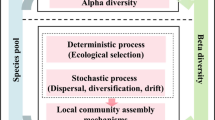Abstract
The paucity of knowledge addressing the role of fragmentation in clonal plant ecology emphasizes the need for plant biologists to focus attention onto the ecological and evolutionary contexts of fragmentation as a trait in its own right, not merely the absence of integration.

Similar content being viewed by others
References
Alpert P, Stuefer J (1997) Division of labour in clonal plants. In: de Kroon H, van Groenendael J (eds) The ecology and evolution of clonal plants. Backhuys Publishers, Leiden, pp 137–155
Brock JL, Fletcher RH (1993) Morphology of perennial ryegrass (Lolium perenne) plants in pastures under intensive sheep grazing. J Agric Sci, Camb 120:301–310
Brock JL, Hay MJM, Thomas VJ, Sedcole JR (1988) Morphology of white clover (Trifolium repens L.) plants in pastures under intensive sheep grazing. J Agric Sci, Camb 111:273–283
Brock JL, Hume DE, Fletcher RH (1996) Seasonal variation in the morphology of perennial ryegrass (Lolium perenne) and cocksfoot (Dactylis glomerata) plants and populations in pastures under intensive sheep grazing. J Agric Sci, Camb 126:37–51
Caraco T, Kelly CK (1991) On the adaptive value of physiological integration in clonal plants. Ecology 72:81–93
Coddington JA (1988) Cladistic tests of adaptational hypotheses. Cladistics 4:3–22
Cook RE (1979) Asexual reproduction: a further consideration. Am Nat 113:769–772
Eriksson O, Jerling L (1990) Hierarchical selection and risk spreading in clonal plants. In: van Groenendael J, de Kroon H (eds) Clonal growth in plants: regulation and function. SPB Academic Publishing, The Hague, 79–94
Harper JL (1978) The demography of plants with clonal growth. In: Freysen AHJ, Woldendorp JW (eds) Structure and functioning of plant populations. North-Holland Publishing, Amsterdam, 27–48
Hay MJM (1994) Autecology of white clover (Trifolium repens L.) with special reference to the effect of stolon burial on branch formation. Ph.D. Thesis, Massey University, Palmerston North, New Zealand
Hay MJM, Chapman DF, Hay RJM, Pennell CGL, Woods PW, Fletcher RH (1987) Seasonal variation in the vertical distribution of white clover stolons in grazed swards at seven sites throughout New Zealand. N Z J Agric Res 30:1-8
Hay MJM, Brock JL, Thomas VJ (1989a) Density of Trifolium repens plants in mixed swards under intensive grazing by sheep. J Agric Sci, Camb 113:81-86
Hay MJM, Brock JL, Thomas VJ (1989b) Characteristics of individual white clover plants in grazed swards. Proc XVI Int Grassl Cong, Nice 2:1051-1052
Hay MJM, Chu ACP, Knighton MV, Wewala S (1989c) Variation with season and node position in carbohydrate content of white clover stolons. ProcXVI Int Grassl Cong, Nice 2:1059-1060
Herben T (2004) Physiological integration affects growth form and competitive ability in clonal plants. Evol Ecol 18:493–520
Hodge A (2004) The plastic plant: root responses to heterogeneous supplies of nutrients. New Phytol 162:9–24
Hutchings MJ, Bradbury IK (1986) Ecological perspectives on clonal perennial herbs. BioScience 36:178–182
Jónsdóttir IS, Watson MA (1997) Extensive physiological integration: an adaptive trait in resource-poor environments? In: de Kroon H, van Groenendael J (eds) The ecology and evolution of clonal plants. Backhuys Publishers, Leiden, 109–136
Kelly CK (1990) Plant foraging: a marginal value model and coiling response in Cuscuta subinclusa. Ecology 71:1916–1925
Kelly CK (1992) Resource choice in Cuscuta europaea. Proc Natl Acad Sci 89:12194–12197
Kelly CK (1994) On the economics of plant growth: stolon length and ramet initiation in the parasitic clonal plant Cuscuta europaea. Evol Ecol 8:459–470
Kelly CK (1995) Thoughts on clonal integration: facing the evolutionary context. Evol Ecol 9:575–585
Kelly CK, Woodward FI (1996) Ecological correlates of plant range size: taxonomies and phylogenies in the study of plant commonness and rarity in Great Britain. Phil Trans Royal Soc (London) B 351:1261–1269
Kelly CK, Harris D, Perez-Ishiwara R (2001) Is breaking up hard to do? Breakage, growth, and survival in the parasitic clonal plant Cuscuta corymbosa (Convolvulaceae). Amer J Bot 88:1458–1468
de Kroon H, Schieving F (1990) Resource partitioning in relation to clonal growth strategy. In: van Groenendael J, de Kroon H (eds) Clonal growth in plants: regulation and function. SPB Academic Publishing, The Hague, 113–130
Kun A, Oborny B (2003) Survival and competition of clonal plant populations in spatially and temporally heterogeneous environments. Community Ecol 4:1–20
Mack RN, Thompson JN (1982) Evolution in steppe with few large, hooved mammals. Am Nat 119:757–773
McCrea KD, Abrahamson WG (1985) Evolutionary impacts of the goldenrod ball gallmaker on Solidago altisima clones. Oecologia 68:20–22
Mágori K, Oborny B, Dieckmann U, Meszéna G (2003) Cooperation and competition in heterogeneous environments: the evolution of resource sharing in clonal plants. Evol Ecol Res 5:1–31
Oborny B, Kun A (2002) Fragmentation of clones: How does it influence dispersal and competitive ability? Evol Ecol 15:319–346
Pitelka LF, Ashmun JW (1985) Physiology and integration of ramets in clonal plants. In: Jackson JBC, Buss LW, Cook RE (eds) Population biology and evolution of clonal organisms. Yale University Press, New Haven, 399–435
Stuefer JF, Gómez S, Mölken TV (2004) Clonal integration beyond resource sharing: implications for defence signalling and disease transmission in clonal plant networks. Evol Ecol 18:647–667
Wilhalm T (1995) A comparative study of clonal fragmentation in tussock-forming grasses. Abstr Bot 19:51–60
Author information
Authors and Affiliations
Corresponding author
Rights and permissions
About this article
Cite this article
Hay, M.J.M., Kelly, C.K. Have clonal plant biologists got it wrong? The case for changing the emphasis to disintegration. Evol Ecol 22, 461–465 (2008). https://doi.org/10.1007/s10682-007-9193-5
Received:
Accepted:
Published:
Issue Date:
DOI: https://doi.org/10.1007/s10682-007-9193-5




